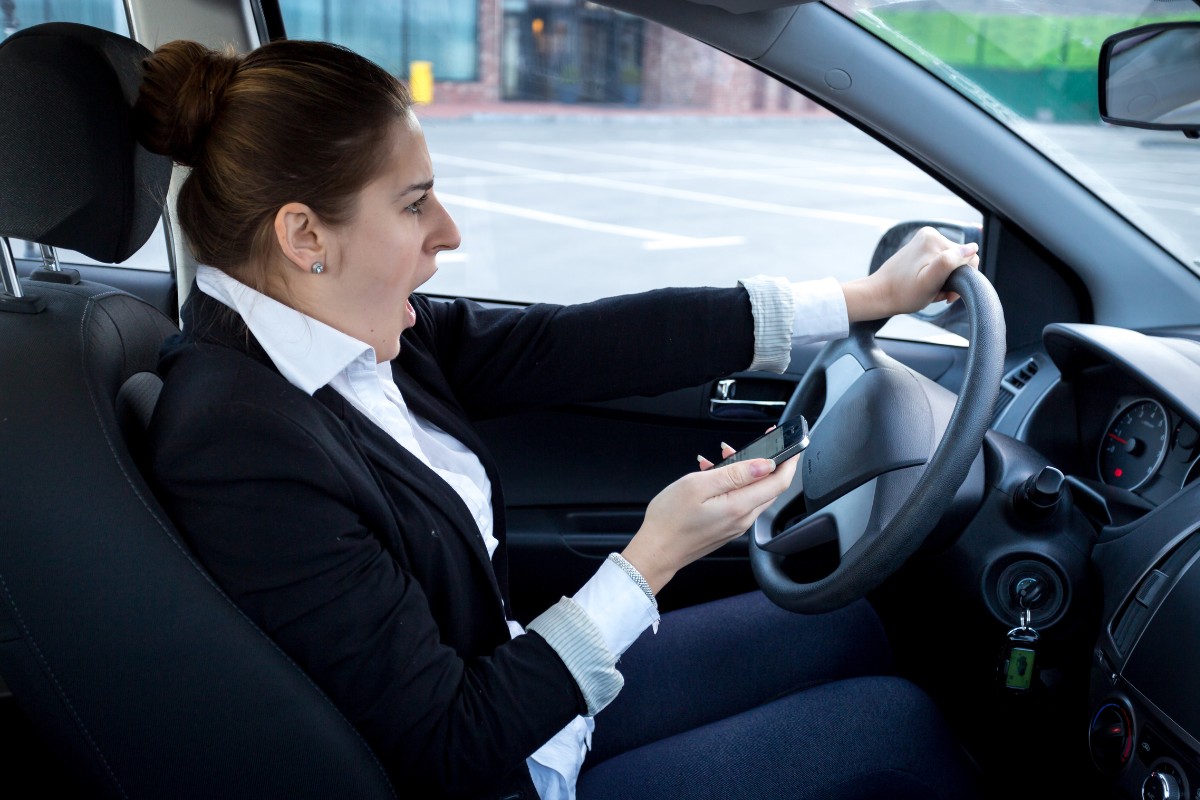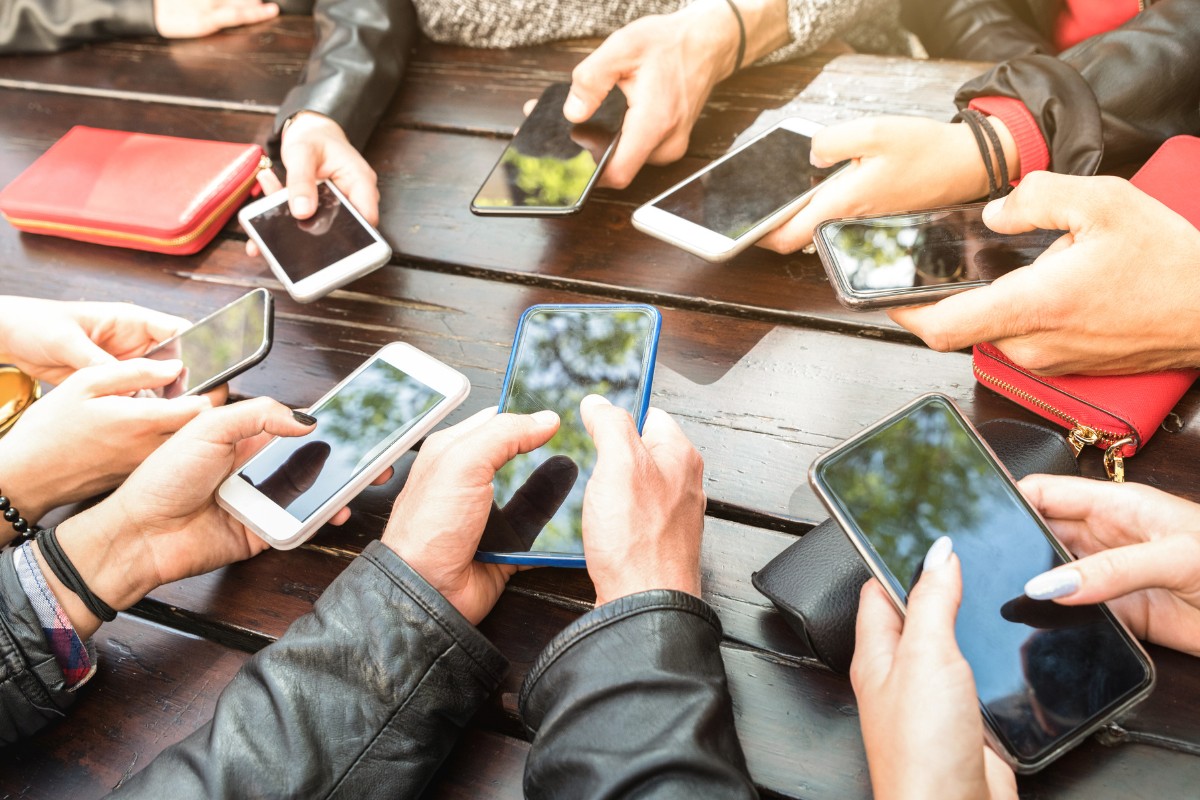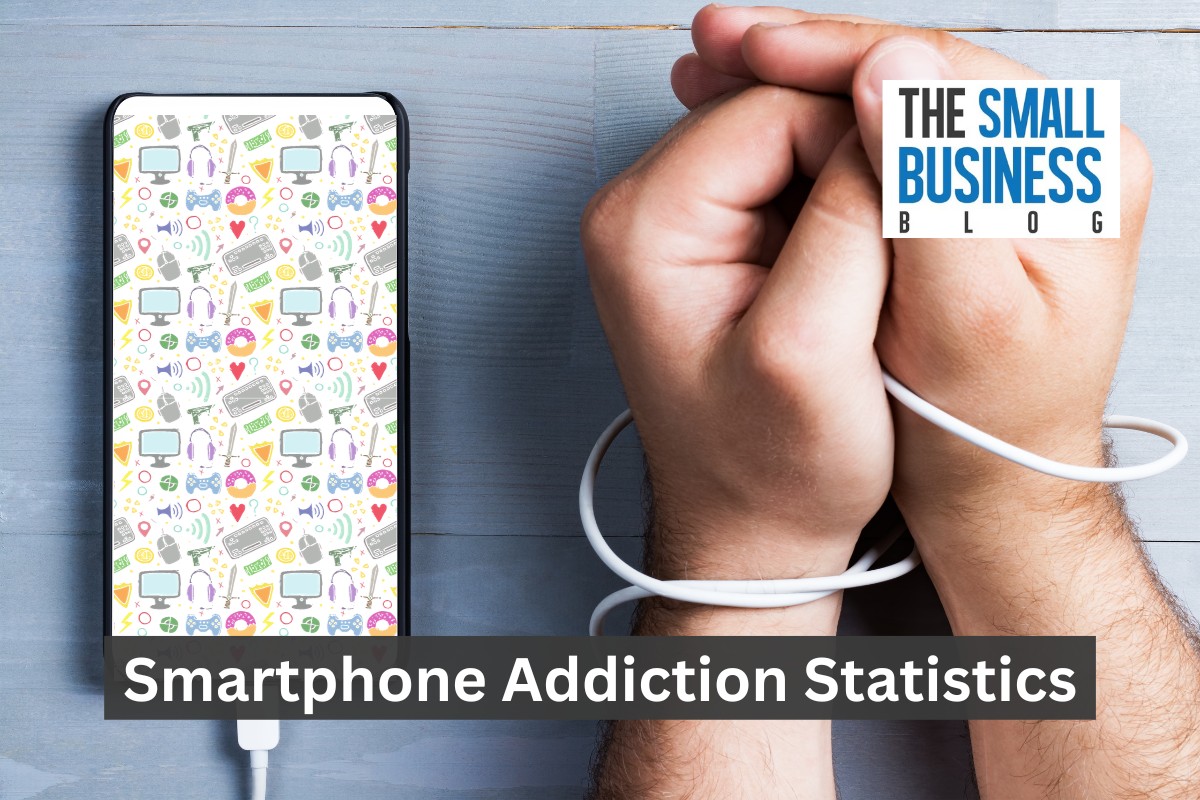Addictions centered around technology are more of a concern than ever before, and you can find plenty of truth in that by reviewing smartphone addiction statistics.
A piece of technology that you carry with you every day, most people interact with their smartphones more than any other device.
With 47% of Americans agreeing that they’re addicted to their smartphones, it’s evident that this is a growing problem.
In this article, you’ll get a comprehensive look at numerous statistics that highlight the severity of smartphone addiction in our technological era.
Post Contents
Key Statistics
- 47% of Americans are addicted to their phones
- The average American tends to check their smartphone at least 352 times every day
- Roughly two-thirds of children spend four or more hours on smartphones every day
- 20% of car accidents stem from cellphone use
- 44% of adults in America admit that not having their phone on them gives them anxiety
- Today’s smartphone users receive 427% more texts and notifications than 10 years ago
- This same demographic also sends 278% more texts
- Phone addiction has a direct correlation to rising suicide rates over the last 10+ years
- 6.3% of the total global population is addicted to their smartphone
Smartphone Addiction Statistics in 2024: The Harsh Reality
Most people would never admit it, but the truth is that a majority of the public spends way too much time on their cell phones.
Society has normalized the use of smartphones in everyday life.
When you consider the numerous applications and services that are tied to our phones and other technologies in our lives, it makes sense why we seem glued to them all the time.
However, the reality is that a lot of it is unnecessary.
One could argue that the world functioned fine before a 400+% increase in messages and notifications.
Between marketing, societal norms, gamification, and a variety of other factors, the public has been trained to be on their phone as often as possible.
1. How Often do Americans Check their Phone?
Whether it’s to be used as a distraction or an endless onslaught of notifications, most Americans check their phone all throughout the day.
A lot more than you might think actually, as the average American checks their cell phone at least 352 per day.
It’s interesting to think about how many were entirely meaningless and how many warranted their attention.
There are many aspects of smartphones that train us to keep checking them, but it isn’t always a necessity.
You’re guaranteed to see varying statistics on this topic depending on the country you look at.
In some cultures, being on your phone at all hours of the day is extremely normalized.
A lot of this has to do with social norms and what’s deemed accepted in everyday public settings.
(ExplodingTopics)
2. It’s Affecting Children Drastically

Unfortunately, another angle that has been normalized is sticking kids in front of screens.
Although this is perfectly fine in controlled moderation, a majority of children are spending too much on smartphones.
Not only is this technology designed to be addictive, but it isn’t the greatest for young developing minds, especially in excess.
Roughly two-thirds of children spend four or more hours on a smartphone every day.
This is far too much and is a clear sign of addiction to tech at a young age.
Many people aren’t considering the short and long-term side effects of such choices, and it’s starting to show on a societal level.
Being so ingrained in technology at a young age can stunt many aspects of normal development.
One that sticks out among others is social skills.
Plenty of young people are having a hard time navigating the real world as they spend much of their youth on a smartphone.
(ExplodingTopics)
3. The Notifications Never End
Part of what reinforces smartphone addiction is the constant sound of new notifications that happen all throughout the day.
This is an immediate distraction for most people, and a majority of us have been trained to check our smartphone every time we hear it.
When you compare today’s data with numbers from ten years ago, the difference is pretty shocking.
Smartphone users in today’s world receive 427% more notifications than they did a decade ago.
On top of that, this same demographic also sends 278% more messages than they did ten years ago.
Everyone has been affected by the rise of smartphones.
Some use the technology more than others, but the truth is that we all check our phones more often than we actually need to.
(AddictionCenter)
4. Cellphone Use and Car Accidents

Before this rise of smartphones, we didn’t have any statistics on cellphone-related car accidents.
Nowadays, it’s such a common concern that new drivers are warned about this problem on the road.
20% of all car accidents are due to cellphone use.
It could be as simple as glancing at a notification or choosing a new song; all it takes is a second of distraction to cause a wreck.
The unfortunate reality is that some of the wrecks in this statistic were fatal.
It’s crucial to practice cellphone safety when operating a vehicle, regardless of how good of a driver you think you are.
This is just another angle on smartphone usage that has been normalized in society.
If you look around when you’re on the road, you’re guaranteed to see numerous people using their phones while driving.
(ExplodingTopics)
5. Smartphone Addiction is a Global Problem
Across the entire world, there are about 3.8 billion smartphone users in total.
Among these people, 6.3% of them have a smartphone addiction.
That comes out to 239,400,000 people.
The problem society faces as a whole is the fact that technology tends to move faster than the average person can keep up with.
It’s overwhelming to some and causes a convoluted life of chasing one tech trend after another.
Smartphones are more than just a trend, and people of all ages have their eyes attached to them on a daily basis.
Smartphone addiction can create several potential health concerns as well:
- Lower concentration
- Lonliness
- Stress
- Psychological disorders
- Reduced cognition
- Anxiety
- And much more
Even though there’s plenty of data and science behind this topic, many people still refuse to believe the reality.
We’re seeing a wave of mental health issues in younger generations, a lot of which stem from smartphone use and the internet.
(AddictionCenter)
How Smartphones are Affecting Americans
It’s no secret that smartphone addiction is a global problem, but a lot of the core statistics around the topic start with America.
There’s a lot of data on smartphone use among American citizens, and unfortunately, the reality isn’t the most charming.
Young and old alike, many people in America are stuck on their phones from the moment they wake up until they go to sleep.
This may not be one long marathon, but with many Americans checking their phones over 300 times per day, it might as well be all day.
Nevertheless, this section will focus on more niche data points on how Americans use their smartphones.
6. Most People in America Own a Smartphone

Smartphones have been around for well over a decade now.
There was a time when some people had smartphones and others had flip phones, but those days are long gone.
Over half of the world owns at least one smartphone, and in America, 85% of people have a smartphone.
This number has gone up drastically over the last ten years.
If you look at data taken from 2011, only 35% of Americans had a smartphone.
Don’t get me wrong, a cellphone is pretty much essential nowadays.
The main argument is the amount of time we choose to spend with the technology.
That 85% in America goes higher when you only factor in people under the age of 50.
Smartphone ownership in this demographic is at 95%, which is pretty much everyone.
Addiction in this space will be challenging to combat, but it all starts with awareness, which is what society is going through as we speak.
(ExplodingTopics)
7. Issues with Ease of Access
Now that everyone is walking around with tiny computers in their pockets, people are spending more time online than ever before.
Most people use the internet to some degree on a daily basis, but there are plenty of health concerns related to being chronically online.
Around 31% of adults in the U.S. admit that they are “constantly online.”
Of course, this doesn’t mean they’re on the internet every second of the day, but they’re acknowledging that they’re on it any chance they get.
This is made easy with the help of smartphones, once again adding to the point that smartphones can be a massive distraction.
It’s no surprise that younger people spend more time online.
The age range that takes the cake here is 18 to 29-year-olds, with 48% admitting that they’re constantly online.
(PewResearch)
8. Separation Anxiety with Smartphones
A majority of people are rarely ever without their cell phones.
Data shows that in America, 55% admit that they have never gone longer than 24 hours without their phone on them.
This makes sense for many different reasons, but it highlights how most people are attached at the hip to their phones.
Other notable statistics in this same demographic include:
- 60% sleep with their phone near them at night
- 46% use their phone at least once while on a date
- 47% feel a sense of anxiety when their phone reaches below 20% in battery life
- 75% use their phones on the toilet
- 89% of Americans check their phones within the first 10 minutes of waking up
These statistics focus on different angles, but they all show how people are attached to their phones, no matter what they’re doing.
Years ago, cell phones were used as a necessary form of communication.
Although that’s still true today, the technology of smartphones has gone far beyond that.
Now, our personal phones are small entertainment hubs in our pockets for the most part.
(Reviews)
9. Statistics are Constantly Changing
You can only get so accurate with your date when it comes to this topic, as each person is bound to engage with their smartphone differently.
Nevertheless, the data in this article offers a thorough visualization of the issue, but you also have to consider how data changes over time.
As an example, take a look at the table below, as it gives comparisons between 2022 and 2023 on various sentiments regarding smartphones.
| Question | 2022 | 2023 | Difference |
| Do you use your phone when you drive? | 41.20% | 27.10% | -14.10% |
| In the event of a life-threatening disaster in your home, would you try to take your phone with you? | 55% | 81.80% | 26.80% |
| Does having someone else use your phone cause anxiety? | 49.50% | 44.70% | -4.80% |
| Have you ever incurred debt from purchasing a new smartphone? | 28.80% | 17.40% | -11.40% |
| Do you think you’re addicted to your smartphone? | 51.90% | 56.90% | 5% |
There are many other questions that I could pull from, but you can get a gist of how things differ over time from the percentages above.
In just one year, the numbers behind these questions have changed quite a bit.
Many factors affect this type of data, so you can’t really attribute it to one primary catalyst.
The reality is that some years are better than others for cellphone addiction, and it’s a problem that should be consistently addressed moving forward.
(Reviews)
10. Americans Spend a Lot of Time on Their Phones
The same could be said for many other countries as well, but Americans spend roughly four hours and 25 minutes on their smartphones every day.
This is a lot, to say the least, and it’s generally a blend of entertainment and to-do lists.
When you consider this stat on a yearly scale, that stacks up to roughly 65 days of smartphone use throughout the year.
Over two months of the entire year is spent looking at a phone screen.
If that’s enough to shock the system, I’m not sure what will.
Due to smartphone use being normalized in essentially every occurrence, this figure will likely get worse in the coming years.
Keep in mind that this stat merely focuses on America and doesn’t consider other parts of the world that might be much worse off.
There’s no argument that smartphones are used for many necessities in our personal and professional lives.
However, it wouldn’t hurt to find a way to reduce screen time in any way you can for the sake of your mental well-being.
(Reviews)
Concerns Surrounding Smartphone Addiction
With all of this data available on smartphone addiction, it raises a lot of concerns on a societal level.
People are wondering what could be done about the issue, considering smartphones won’t be axed out of the picture.
It starts with addressing the various dangers associated with smartphone addiction and then working through the solutions.
The following statistics will focus on the dangers related to smartphone addiction and how they’re affecting users.
11. Smartphones Waste a Lot of Time
We’re all well aware that the amount of time we spend on our phones isn’t always productive.
Picking up your smartphone is habitual for most people, and 42% of Americans admit that they waste too much time on their phones.
Recognizing it is a good first step, but due to the habitual nature of the actions, it can be hard to ignore your phone.
This is where muting notifications can help.
With your phone pinging you all day, it can be hard to leave it alone.
There are many mental associations with picking up your phone.
Even though the addiction is a real problem, it’s something that can be fixed with a little self-awareness and practice.
Cell phones have been around for quite some time, but in the grand scheme of things, smartphones are still new to many people in the world.
At this point, society is still running on that high of evolving technology, which seems to never come to a halt.
(ExplodingTopics)
12. Poor Quality Sleep

As we all wind down in the evenings, a majority of us tend to spend a little time on our smartphones before bed.
This can be easy to do as you have nothing else left in the day, and your phone is generally right next to you at bedtime.
People get stuck in doom scrolling, which inevitably affects healthy sleeping patterns one night after another.
In a study that focused on residents in the U.K., 69% of those who were smartphone addicted reported having poor sleep quality.
On the other hand, 57% of non-addicted participants didn’t have this particular issue.
There’s more than enough data to support technology’s effect on our sleep cycles, but many of us still get stuck in doom scrolling every night before bed.
Once again, many practices can be put in place to beat this habit, but the first step is recognizing the pattern.
(Frontiers)
13. Complications with Mental Health
Mental health is a primary concern related to smartphone addiction.
Another issue that stacks on top of this is that mental health can many times stem from physical health.
There’s a decent amount of data available on how smartphone use affects our health.
Below is a brief list of some of the known health complications that can arise from smartphone addiction.
- Depression
- Anxiety
- Impulsivity
- Low self-esteem
- Shyness
- Emotional regulation
- And more
We’re seeing plenty of issues with these in essentially every generation nowadays.
It’s much more prevalent in young people as they can be persuaded much more easily.
Older generations spent a good portion of their lives without smartphones, so they approach the technology a bit differently.
Part of the reason we’re seeing limited progress in addressing smartphone addiction is that nearly everyone is addicted.
If everyone is addicted, then the masses will have a much harder time accepting that fact.
Smartphone addiction is also known to have comorbidities with various mental health disorders.
Whether it’s ADHD, OCD, depression, anxiety, or even alcohol use disorder, smartphone addiction can exacerbate these health issues.
(ExplodingTopics)
14. Catching Signs of Smartphone Addiction
With 16% of young people under 30 being addicted to smartphones, it’s time to start learning how to address the problem as early as possible.
This figure is bound to grow in the coming years, which is why it’s important that friends and family are able to catch signs of smartphone addiction.
It can be tricky, as each person reacts and engages with the technology in their own way.
A few known signs of addiction to smartphones include some of the following:
- Choosing to isolate from loved ones
- Lying about how much they use their phone
- Getting up at night to check their phone
- Limited or non-existent social life
- Feeling a lack of connection with others
- Constantly reaching for their phone when they aren’t doing something
- Increasing mental or physical health issues due to phone use
Many people may never experience any of these issues, but that’s not the case for everyone.
Considering the demographic of people being affected by smartphone addiction is growing, it’s a problem society will have to face for the foreseeable future.
(AddictionCenter)
15. Effective Treatment Options for Smartphone Addiction

Although smartphone addiction is always under ongoing research, there are a handful of treatment options that are known to be quite effective.
They definitely won’t work for everyone, but there’s plenty people can do to break their repetitive and dependent habits with their smartphones.
A few known treatments for smartphone addiction include:
- Group therapy
- Psychotherapy
- Medication-assisted treatment
- Cognitive behavior therapy
- Counseling
If you or someone you know is struggling with smartphone addiction, there are numerous options available to help tackle the problem.
Technology has a growing grip on humanity, and smartphones are one of the biggest culprits of this ongoing debacle.
(AddictionCenter)
Final Thoughts
It’s understandable to use your smartphone on a daily basis.
Many of the features they provide are essential in modern life.
However, there’s also a big portion of smartphone tech that isn’t needed whatsoever.
From doom scrolling to addiction or simple everyday habits, smartphones are in our hands a bit too often nowadays.
The smartphone addiction statistics in this article offer a stark reality that will have to be addressed sooner rather than later; otherwise, it’ll only get worse with time.






























